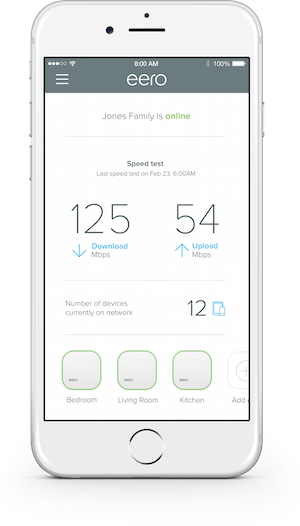How data powers the future of WiFi
In talking to friends and colleagues, it’s been interesting to see that while it may seem intuitive that data would help make WiFi better, many people have a hard time understanding how. In the months after launch, users reported that some devices weren’t recognizable in the connected device list shown in the eero app. As it turned out, many devices didn’t have hostnames (or had non-user-decipherable ones like “dp-539500GP” for an Amazon Echo). Defaulting to the MAC address to identify a manufacturer also came up short, as MAC addresses often come from a different manufacturer than the end product. For instance, some Windows devices show up as ‘Intel’ because Intel makes the WiFi radios for the computers. Similarly frustrating, people with multiple devices from the same manufacturer weren’t able to tell the difference between them. Both an Amazon Fire TV and an Amazon Kindle appeared as ‘Amazon.’ To solve this, eero’s resident data scientist came up with a plan to better identify devices by their characteristics. Using device specific “fingerprints,” such as connection speed, WiFi performance, and rate of data transferred over time, we’ve been able to pinpoint device types and more accurately display them in the app. And that’s simply a taste of how data is helping eero build the future of WiFi.
As more and more devices come online, WiFi quality becomes increasingly important to our day-to-day lives. In order to ensure eero WiFi systems provide the best possible experience, we use data to improve the software on each and every network. Interestingly, eero networks make up one of the largest collections of WiFi access points in the world. Not even wireless researchers at MIT have access to this quantity and variety of networks, which allow us to continuously test and refine different meshing algorithms. Every eero routinely sends a few key pieces of diagnostic data to the cloud: temperature sensors, MAC addresses, WiFi spectrum scans, speed test results, and bandwidth usage. As more eeros come online, diagnostic information from each eero helps us improve performance at statistically significant scale. In addition to enriching the user experience, this data is aggregated and anonymized, and then used to identify, diagnose, and fix bugs across the larger eero community.
How we surface data to users
The eero app allows users to monitor performance and keep track of connected devices on the network. We imagine that a future version of the app will provide a snapshot of network usage by user, by device, and over time. For instance, a customer could view the amount of data transferred by an Xbox One on a school night or bandwidth used by an Apple TV during the day, as well as learn tips on how to optimize performance of these devices.
How we use data internally
Data isn’t just important for our customers — all of our teams rely on it. The product team runs A/B tests of new features to evaluate how customers interact with them. They use anonymized and aggregated data to dig into trends around connected devices: the most popular, the most returned to stores, and the latest-to-market. Outside of the home, we can evaluate ISPs and how they perform for our customers. In fact, during a recent hackathon — a quarterly opportunity for employees to work on projects of their choosing — a few engineers leveraged our big data infrastructure to build a tool to display real-time regional ISP or power outages on a map of the US.
With each new software release, data helps us evaluate which things we need to fix, if our fixes actually work, and if the new releases cause any interoperability issues between eeros and other devices. The networking engineering team leverages spectrum scans, connection strength information, and error logs to continually refine the software on eero systems and improve speeds, latencies, and stability across all networks.
The eero data team
eeros produce a tremendous amount of data, and as the number of active eeros continues to grow, the data team is challenged to keep up with the data volume. In aggregate, learnings from this data allows us to continue to improve WiFi, networking, and life at home. The work we’re doing today — building the infrastructure to ingest and digest this data and turning it into usable pieces for our customers — will allow us to efficiently scale into the future. And making these analytics easily accessible to different teams throughout the company will help all functions make more informed decisions.
The data we have helps us answer important questions: How do we make WiFi perfect for our users? How do we scale to one million eeros? And then five million? And then twenty million? What does that look like in the next two, five, or twenty years as more eeros come online? We’re currently in search of a Head of Data Engineering and Analytics to help us tackle these challenges. This person will continue to build out the team, architect our data infrastructure, and determine the future of data at eero. They’ll define what’s possible with data and ensure it continues to be part of our competitive advantage. If you’re interested, learn more here.




You must be logged in to post a comment.